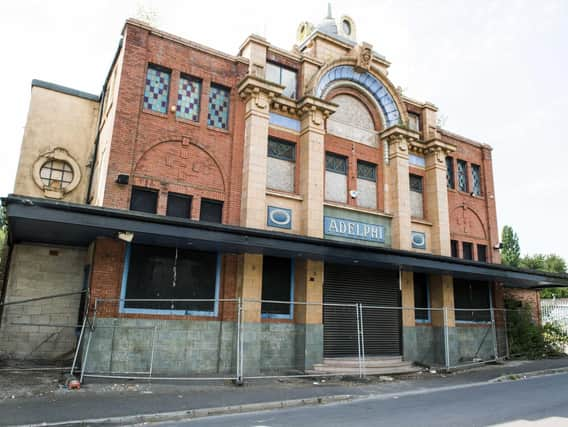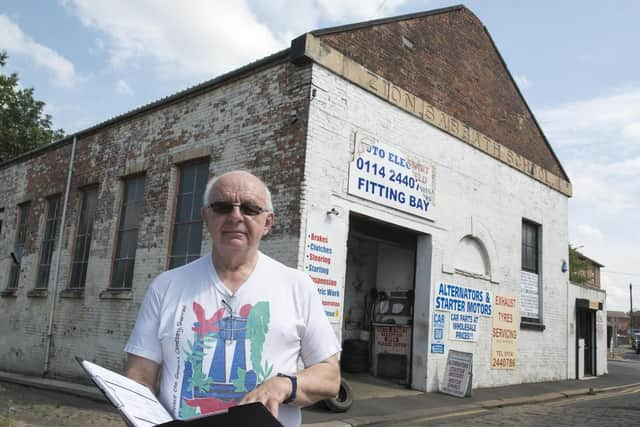Sheffield's Heritage Open Days 2018: A walk around the past and future of Attercliffe


History expert Mike Higginbottom is standing on Bodmin Street in the Sheffield suburb beside the repurposed Wesleyan Reform Church - a once-derelict building that is now the Jamiyat Tableegh ul Islam Mosque.
He points at the foundation stones in the wall, dating from 1890, and reels off a list of names. Here is Sir Frederick Mappin, the Master Cutler, mayor and MP, Jethro and Samson Chambers who owned the Effingham Mills, and the wife of Sir Robert Hadfield - all of them top industrialists whose endeavours helped the area to thrive.


Advertisement
Hide AdAdvertisement
Hide Ad"These are big hitters in the steel industry," says Mike animatedly. "Down in darkest Attercliffe, two baronets turned out to lay foundation stones. There's so much under the surface about this place, it's not just 'Eeh bah gum ecky thump'."
The mosque will be the last call on a two-hour walking tour he is leading as part of Sheffield's Heritage Open Days - the annual festival that is offering more than 100 free events from tomorrow.
The guided stroll will take in key sites giving an insight into the past, when the Lower Don Valley was the powerhouse of Sheffield's heavy steel trade and Attercliffe where its workers lived. Back then it had the air of a mini city centre - today the atmosphere is different. The main road thunders with heavy traffic and the proliferation of sex shops confirms the area's reputation as a red light district.
"There were two Burtons' tailors, a Littlewoods, a Woolworths, four cinemas and a theatre. After the war. And it's all gone," says Mike.
Advertisement
Hide AdAdvertisement
Hide AdBut there are signs of a brighter future - the Don Valley Stadium site, where the Brown Bayley factory once produced steel and became a target for Nazi bombs during the Blitz, is becoming the Olympic Legacy Park and the Oasis Academy school is up and running.
"I'm all in favour of the place being redeveloped because at the moment it's really neither one thing nor the other," says Mike. "But I'm not sure whether the heritage is going to be safeguarded. This place hasn't changed that much in the last 10 years."
An entry in the Domesday Book - Ateclive, meaning 'at the cliffe', an escarpment beside the River Don - is the earliest reference to the place, where makers of knives and tools based themselves at the dawn of the 19th century.
"The arrival of the canal made industry, and the city, easier to develop," says Mike. "And the arrival of the railway in 1839 - about a mile away - is where all the heavy steel, armaments and so on came from."
Advertisement
Hide AdAdvertisement
Hide AdThe tour starts near the Supertram stop - not far from where the last route of the old-style Sheffield Tramway ended in 1960. Long-demolished terraced homes once surrounded the spot.
"The density of housing and industry is hard to believe when you walk about now," says Mike, who was a schoolboy in Attercliffe. His event is a repeat of a walk held in 2017 which attracted a 'huge waiting list'.
"There's a lot of nostalgia," he says by way of explanation. "There are a lot of people of my age who grew up here before it started to be cleared. If you look on the nostalgia websites there's all this stuff about 'Oh, what a wonderful community, why did they knock it all down'. My memory of my parents and their siblings is they couldn't wait to get out because they wanted indoor sanitation, central heating and preferably somewhere to hang their washing other than indoors."
Pollution was the biggest problem - "It was physically filthy," he says - but nevertheless there is 'a huge amount to celebrate'. "The heritage bits that survive therefore are all the more valuable. More valuable than if they were just anywhere. And yet there needs to be a perspective that after the war particularly, it was not a good place to live. There was nothing wrong with the community."
Advertisement
Hide AdAdvertisement
Hide AdMike used to be an English teacher at Ecclesfield secondary school and also taught archaeological history part-time, mainly for Nottingham University. This is how he came to organise tours which he now provides through his own venture called Interesting Times.
He walks to the corner of Shortridge Street where the former Banner's department store stands, still impressive with its ornate Selfridges-type facade. Now used as a business centre, the building had the distinction of harbouring the first escalators in Sheffield, an arcade and lifts which survive. Mike was fascinated with the cashiers' system for exchanging money, which involved containers of cash being sent up a pneumatic pipe.
"People used to come from Rotherham and stop in Attercliffe to shop rather than go into town. You didn't really need to go all the way into the city."
Further along, a supermarket stands on the site of the Palace theatre, which started in 1898 and switched between live plays and film screenings until 1955. "There are two stories," says Mike. "Dora Bryan claimed she lost her knickers because the bats ate them in the dressing room. And Arthur Askey was annoyed because the bandleader insisted he brought scores for a 24-piece orchestra, and when he got there there was this tiny little pianist. If you believe that you'll believe anything."
Advertisement
Hide AdAdvertisement
Hide AdA stone's throw away is the tour's 'jewel in the crown', the Zion Graveyard where anti-slavery campaigner Mary Anne Rawson is buried. "A forgotten figure that needs reviving," Mike says. The cemetery takes its name from a congregational church pulled down in the 1980s. The associated Zion Sabbath School still exists, albeit occupied by an MOT garage.
Facts abound - on the gable of the closed Britannia pub the date 1772 is written in black letters; legend has it the numbers were cast by steelmaker Benjamin Huntsman, whose forge was next door.
For a long time, Mike says, there were two distinct communities in Attercliffe. "If your dad was a cutler, you followed him, and if your dad was in the steelworks he'd have a word with the foreman and get you a job. They stayed separate for quite a long time."
Meanwhile the Attercliffe Liberal Club, founded in 1882 and opened by Liberal MP A.J. Mundella, is still in business. "I think that's really wonderful," he remarks.
Advertisement
Hide AdAdvertisement
Hide AdThe sight of the grand Adelphi - disused since 2006 and one of Sheffield's two Grade II listed cinemas along with the Abbeydale Picture House - is a treat, tucked away on Vicarage Road. Its decorative tiles are in fair condition and, behind the nightclub paraphernalia inside, there should be 'an intact 1920s cinema interior', Mike thinks.
He agrees that, if it happened to be in the city centre, the venue would become a fashionable food hall, 'or a Wetherspoons'. "It's waiting."
Under 1960s planning policy, the whole of Sheffield's east end was designated for industry rather than housing, an idea that backfired when steel went into decline. But there has been some new residential development. Mike takes a turn up Britnall Street, where homes were built at the turn of the millennium, saying: "The Attercliffe nostalgia brigade would be justified in saying, 'Why didn't they do this in the first place?'"
In the middle of the cul-de-sac is an unusual feature reclaimed from a factory - a huge black drop hammer that would have banged up and down to flatten molten steel.
Advertisement
Hide AdAdvertisement
Hide Ad"That was the sound I used to be rocked to sleep by," Mike says.
A Walk Round Attercliffe takes place next Thursday, September 13, from 10am to midday, starting and finishing at the Attercliffe tram stop. Call 01142420951 or email [email protected] to book. Heritage Open Days happen from September 6-9, and 13-16. Visit www.heritageopendays.org.uk for listings.
See The Star tomorrow for a feature about Ethel Haythornthwaite, the Sheffield woman who devised the Green Belt.